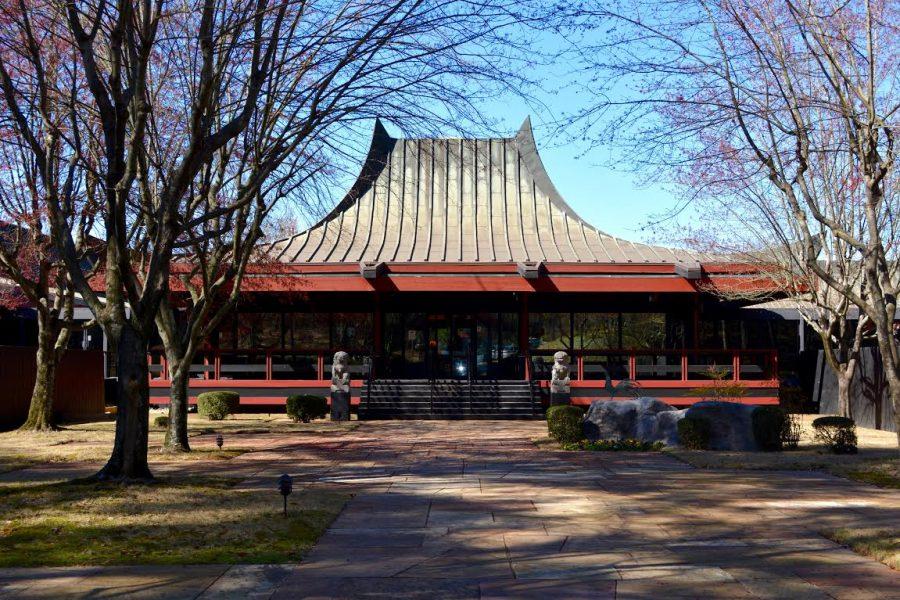Nestled in the Tuscaloosan woods is a building unlike anything else you will see for miles. If someone were to come across it by accident, they might think they’ve been transported to eighth century Japan. Not only is the architecture beautiful, but what’s housed inside is even better – a collection of more than 600 pieces of American art.
The Tuscaloosa Museum of Art is located in this Japanese-style building which was built from 1969 to 1970 by Jack Warner with the help and artful eye of architect Cecil Alexander. During World War II, Warner spent time in Burma, where he fell in love with Far Eastern architecture. He hired Alexander to build a new office for his business, The Westervelt Company, in the style of the Kyoto Imperial Palace in Japan.
“The architecture is just absolutely stunning,” said Will Hawkins, the museum coordinator. “Every day you’re greeted by beautiful scenery driving through the parking lot and when you walk in. Even the woodlands around calm you before you go into work.”
Warner began purchasing artwork as means of investments for The Westervelt Company, previously known as the Gulf States Paper Company.
“It’s hard to find the words to describe it,” Hawkins said about the collection. “It’s considered one of the best private collections of American art anywhere in the country.”
Hundreds of years of American cultural history have been documented through the creative works located in the local collection. Stories hide behind each and every painting, sculpture and piece of decorative art.
Once, Jack Warner disagreed with an artist about the title of a night scene with a riverboat. The artist asked him that if he were to paint Jack into the work, if it would settle the matter. So, a small depiction of Jack Warner in a dashing white coat and top hat can be seen looking over the railing of the riverboat in John Stobart’s enchanting painting.
Works of incredibly famous names from Mary Cassatt to Charles Bird King to artists of the Hudson River School create a collection of pieces that any major museum in New York City or Chicago would love to have.
“Instead of going to the Smithsonian, the Met or the High Museum, you can just come down the street and see us and see the same artists, and in what we think is a little more intimate location,” Hawkins said. “It’s some of America’s greatest artists ever inside the collection.”
The museum is completely free, which is something you don’t encounter often, especially at a museum with such high caliber art. Even the furniture in the collection is exquisite, such as an ornate accordion-style dining room table.
“The reason it’s so significant is that it’s a private collection that’s open to the public,” said Hawkins. “You can walk through the history of our country through the paintings from basically Pre-Colonial America to early 20th century – it’s unique in that aspect.”
The museum offers a number of ways for students and fans to get involved as well. “Art with Friends” is held every third Thursday of the month and invites fans to come enjoy hors d’oeuvres and drinks as well as programs that highlight specific works or time periods of art. Hawkins, who has been with the museum since 2008, leads a volunteer docent programs by teaching a six to eight week Osher Lifelong Learning course through UA twice a year. He tries to inform the class on as much as possible about the collection and its history.
“Once you go through that, if you want to become a docent, you’ll have plenty of material to do tours for either schoolchildren – those are a blast – or you can do adult tours,” Hawkins said.
Their most recent exhibition is a series of Frederic Remington illustrations of figures from the American West. What makes these drawings so important is not so much the immaculate detail, but because Remington is more formally known as a sculpture artist, not an illustrator.
Hawkins invites artists or aspiring artists to come to the museum and sketch because there are more than enough artistic styles to learn from and practice.
“Never hesitate to ask questions while you’re in here,” Hawkins said. “I’m more than happy to get away from my computer and answer questions for anybody. That’s why I love my job; I get to meet interesting people and discuss art and history with them.”
Both Hawkins and Kathie Thurman, the museum’s administrative services coordinator, have offices that sit in the middle of the collection, and they are always more than willing to walk you around and tell stories about each piece. It’s a place filled with the passion for America’s rich history and artistic talent.
“Come see us,” Hawkins said. “It’s a great way just to escape for a little while.”
Located on Jack Warner Parkway, the museum is open Tuesday through Saturday from 10 a.m. to 6 p.m. and Sundays from 1 p.m. to 6 p.m. Check out their Facebook for more information. If you’re interested in the volunteer docent program, email Will Hawkins at whawkins@westervelt.com.









